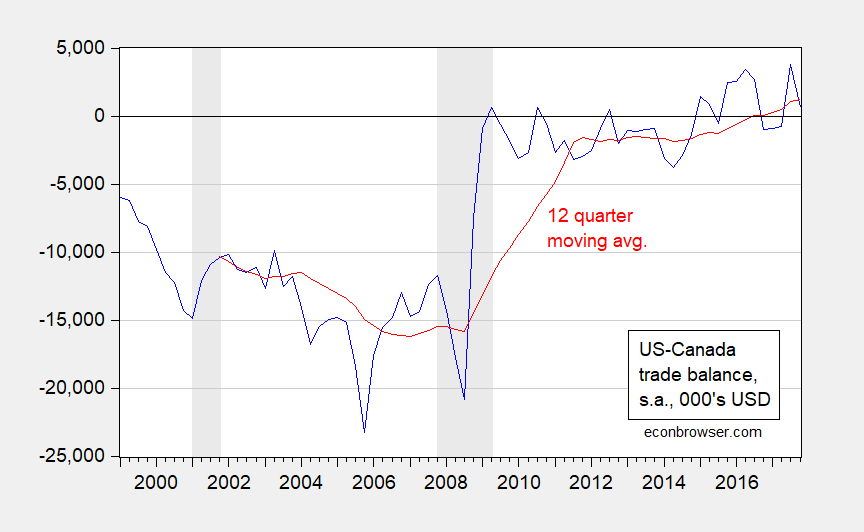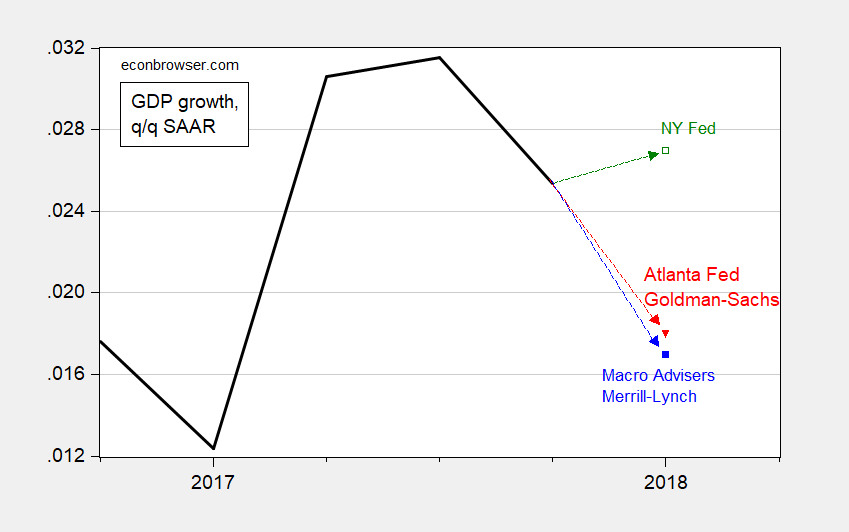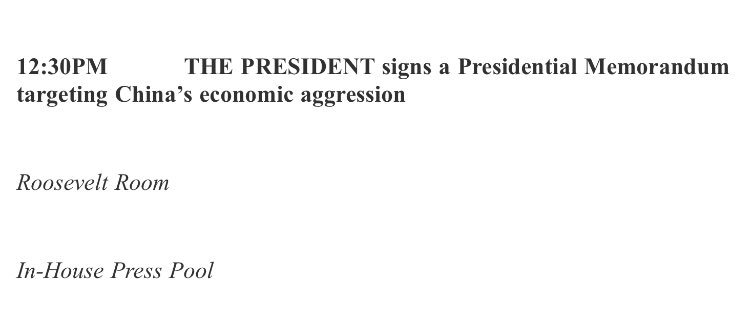US-Canada Bilateral Trade Balance in Goods and Services at Quarterly Frequency
Is the trend more important than if there is actually a surplus or deficit, as one commenter suggests? On a bilateral basis, I don’t think either is particularly important, but as a matter of fact I think we need to verify that the US-Canada bilateral trade balance in goods and services is (barely) positive in 2017, and trending upward on a quarterly basis.

Figure 1: US-Canada trade balance in 000’s US$, s.a. (blue), and 12 quarter trailing moving average (red). NBER defined recession dates shaded gray. Source: BEA, NBER, author’s calculations.
Some GDP Nowcasts

Figure 1: Real GDP growth, actual (bold black), forecast of NY Fed Nowcast 3/16 (green), Atlanta Fed GDPNow 3/16 (red), Goldman-Sachs 3/19 (red), Macroeconomic Advisers 3/16 (blue), Merrill Lynch 3/19 (blue), q/q SAAR. Source: CR, Macro Advisers, Goldman-Sachs.
GDP growth in Q1 has been lower in the past years, few consistent with residual seasonality.
Comparative Employment Growth in California and Wisconsin
Both Governors Brown and Walker are coming to the end of their second terms. Time to appraise how their respective economies have fared, in terms of employment.
Nearly Two Decades of US-Canada Trade Balance Data
There seems to be some confusion regarding the distinction between trade balance in goods and services (a typical macro variable of interest) and trade balance in goods (more commonly reported, but less and less relevant on its own as countries become more service intenstive). In order help remedy this confusion, I plot below freely and easily accessible data, for those willing to expend a few calories to click.
Where Should POTUS Get His/Her Data From?
My view is that if we pay hundreds of millions of dollars per year (we should probably spend more) on collecting and analyzing economic data, we should use that data. Yet, when Mr. Trump debates trade policy with the Canadian prime minister, by his own admission he makes up numbers.
True Believers
Mr. Trump holds forth on how he interacts with other heads-of-state (from TIME):
And by the way, Canada? They negotiate tougher than Mexico. Trudeau came to see me, he’s a good man, he said we have no trade deficit with you, we have none. Donald, please. Nice guy, good looking guy. Comes in. Donald we have no trade deficit. He’s very tough. Everyone else, getting killed or whatever. But he’s tough. I said, well Justin, you do. I didn’t even know. Josh, I had no idea. I just said you’re wrong. You’re wrong. It was so stupid. [LAUGHTER]. I thought it was fine. I said, you’re wrong Justin. He said, nope we have no trade deficit. I said, well in that case I feel differently. I said but I don’t believe it. I sent one of our guys out. His guy, my guy. They said check because I can’t believe it. Well, sir you’re actually right, we have no deficit but that doesn’t include energy and timber. [LAUGHTER]. Well you don’t have timber, and when you do we’ll lost $17 billion. It’s incredible.
USTR notes that the 2016 bilateral trade balance between the US and Canada is +12.9 billion.
And yet there are still people (such as Rick Stryker) who will write:
I believe that Trump is the most honest politician we’ve seen or probably will see in our lifetime.
For this portion of the population, facts will remain irrelevant.
Even Worse than We Thought
The Brownback-Kansas experiment, that is. Revised employment data for Kansas shows that employment was flat for nearly a year and a half, before crashing in mid-2017.
Is California in Recession? (Part IV)
Back in mid-December, Political Calculations asked if California was in recession. Following Monday’s state-level employment release incorporating benchmarked data, we have a better idea of the answer — it’s likely no.
Wisconsin Manufacturing Employment Boom Revised Away
New state level employment data, benchmarked through September 2017, released yesterday indicate the manufacturing employment surge reported last year has been erased, as I predicted in this post. The October-January data do not incorporate additional information from the Quarterly Census of Employment and Wages.
